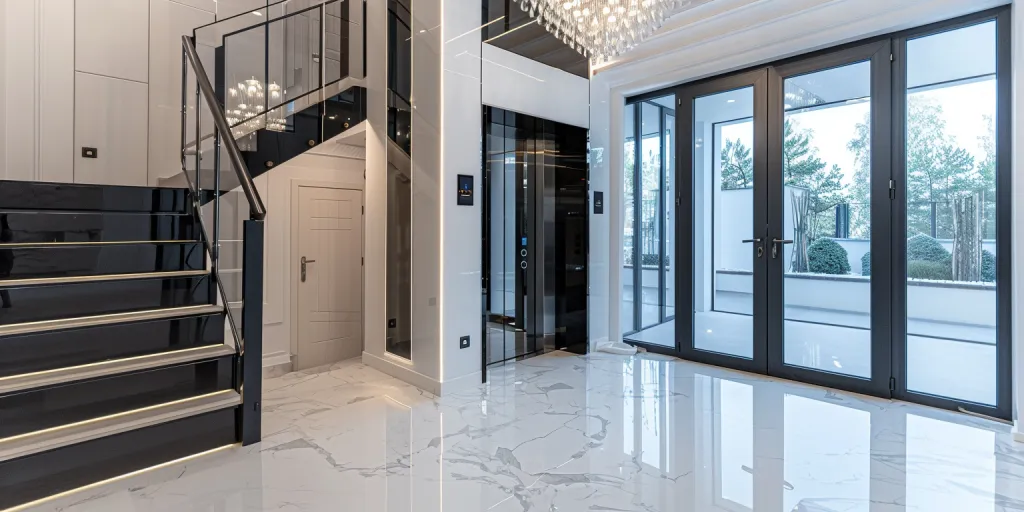Home elevators are no longer just a symbol of luxury; they have become a practical solution for accessibility and convenience in modern residences. This guide delves into the workings, usage, and costs of home elevators, alongside highlighting the top products in the market. Elevate your understanding and your living space with our expert insights.
Table of Contents:
– What is a home elevator?
– How do home elevators work?
– How to use home elevators
– How much does a home elevator cost?
– Top home elevators
What is a home elevator?

Home elevators are vertical mobility solutions designed to facilitate easy floor-to-floor access within a residential setting. Unlike commercial elevators, these are tailored for personal use, emphasizing comfort, style, and integration with the home’s aesthetic. They come in various types, including hydraulic, traction, and pneumatic vacuum elevators, each with its unique installation and operational requirements. Home elevators not only enhance property value but also promote accessibility, making them an increasingly popular addition to modern homes.
How do home elevators work?

The functionality of home elevators varies with their type. Hydraulic elevators, for instance, rely on a piston and pump system within a cylinder to move the elevator car up and down. They are known for their smooth operation and require a separate machine room. Traction elevators use a counterweight system, eliminating the need for a machine room and offering a more energy-efficient solution. Pneumatic vacuum elevators, on the other hand, operate by creating a vacuum above the elevator car to lift it and releasing the vacuum to lower it. This type of elevator is highly aesthetic and requires minimal space and no pit or machine room, making it ideal for retrofitting into existing homes.
How to use home elevators

Using a home elevator is straightforward, with operational controls similar to commercial elevators. They typically feature interior buttons for floor selection and doors that may open manually or automatically. Safety features such as emergency stop buttons, in-cab phones, and backup power systems ensure the user’s safety in case of a power outage or malfunction. Regular maintenance checks are crucial to ensure the elevator’s longevity and optimal performance, with most manufacturers recommending annual inspections by a certified technician.
How much does a home elevator cost?

The cost of home elevators varies widely depending on the type, size, and custom features. Basic models can start from $20,000, while high-end, custom-designed elevators can exceed $100,000. Installation costs add to the total expense, with hydraulic elevators typically requiring more extensive construction work compared to traction or pneumatic models. Additionally, ongoing maintenance and potential retrofitting costs should be considered when budgeting for a home elevator. Financing options and potential tax deductions for accessibility improvements can help mitigate some of these costs.
Top home elevators

When it comes to choosing a home elevator, several brands stand out for their quality, innovation, and customer service. Stiltz Home Elevators offer a range of compact, shaft-less models that are easy to install and fit into small spaces. Savaria is known for its luxurious and highly customizable elevators, catering to those looking for a premium product. ThyssenKrupp Access brings German engineering to the table, with a focus on safety and innovative design. Each brand offers unique features and benefits, making it essential to consider personal needs and preferences when selecting a home elevator.
Conclusion:
Home elevators are a practical and luxurious addition to any residence, offering enhanced mobility and increased property value. Understanding the types, workings, and costs associated with these elevators is crucial for making an informed decision. With the right information and a clear understanding of your needs, you can select the perfect elevator to elevate your home’s functionality and style.





 বাংলা
বাংলা Nederlands
Nederlands English
English Français
Français Deutsch
Deutsch हिन्दी
हिन्दी Bahasa Indonesia
Bahasa Indonesia Italiano
Italiano 日本語
日本語 한국어
한국어 Bahasa Melayu
Bahasa Melayu മലയാളം
മലയാളം پښتو
پښتو فارسی
فارسی Polski
Polski Português
Português Русский
Русский Español
Español Kiswahili
Kiswahili ไทย
ไทย Türkçe
Türkçe اردو
اردو Tiếng Việt
Tiếng Việt isiXhosa
isiXhosa Zulu
Zulu